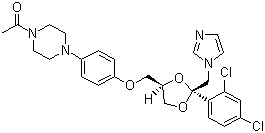10.1002/chem.201103318
The research investigates a class of aminopyrrolic synthetic receptors for monosaccharides, which are carbohydrate-binding agents (CBAs) with potential antibiotic activity against pathogenic yeasts. The purpose of the study was to explore the binding properties, antibiotic activity, and cytotoxicity of these receptors, particularly their interactions with mannosides and their potential as therapeutic targets for viral infections like HIV. The conclusions drawn from the research indicate that these synthetic receptors, especially the tripodal compound 1, exhibit antibiotic activity comparable to known drugs like amphotericin B and ketoconazole, and that their structure plays a critical role in their efficacy. The research also suggests that the pyrrolic groups on these compounds are essential for permeability through the cell wall of pathogens and for activity inside the cytoplasm.
10.1016/j.cclet.2013.11.026
The research focuses on the synthesis of benzimidazole-bearing 2-pyridone derivatives as potential antimicrobial agents to combat multi-drug resistance in bacteria and fungi. The study employed molecular hybridization to combine the bioactive properties of 2-pyridones and benzimidazoles into a single molecular framework. The synthesis involved the preparation of intermediate compounds through reactions with cyanoacetic acid hydrazide and Knoevenagel products, followed by condensation with aromatic aldehydes in boiling ethanol. The synthesized compounds were characterized using elemental analysis, infrared (IR) spectroscopy, nuclear magnetic resonance (NMR) spectroscopy, and mass spectrometry. The antimicrobial activity of the compounds was evaluated in vitro using the broth dilution method against various bacterial and fungal strains, with chloramphenicol and ketoconazole as standard drugs. The study also assessed the cytotoxic effects of the most potent compounds on human cancer cell lines. The findings indicated that compounds with electron-withdrawing groups, particularly at the meta or para position of the phenyl ring, exhibited the highest antibacterial activity, while a chlorine-substituted compound showed the most potent antifungal activity, with none of the tested compounds showing significant cytotoxic effects.
10.3109/14756366.2012.752363
The research aimed to synthesize and evaluate the antifungal and cytotoxic properties of 14 different 2-[(1-methyl-1H-tetrazole-5-yl)thio]-1-(phenyl)ethanone derivatives. The study was motivated by the increasing incidence of fungal infections, particularly those caused by Candida species, and the need for new antifungal agents due to growing drug resistance. The compounds were synthesized using a one-pot method involving 1-methyl-1H-tetrazole-5-thiol and various phenylacetyl bromide derivatives. The structures were confirmed through IR, 1H-NMR, 13C-NMR, FAB-MS, and elemental analysis. The synthesized compounds were tested for their anticandidal activity against eight Candida species using the microbroth dilution method and for cytotoxicity against NIH/3T3 cells using the MTT assay. The results showed that several compounds exhibited potent antifungal activity, with some displaying better efficiency than the reference drug ketoconazole, particularly against C. albicans strains. Compounds 1, 12, and 13 were highlighted for their selective anticandidal effect and low cytotoxicity, suggesting that chloro substitution on the benzene ring enhances antifungal activity. The study concluded that these tetrazole derivatives could serve as potential candidates for the development of new antifungal agents.



 T
T


